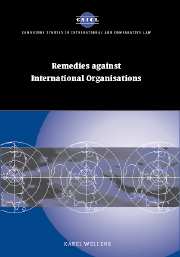Book contents
- Frontmatter
- Contents
- Acknowledgements
- List of abbreviations
- Introduction
- Part I General features of remedies against international organisations
- Part II Procedural aspects of remedial action against international organisations
- 7 Introduction to procedural aspects of remedial action against international organisations
- 8 Procedural aspects of remedial action by member states
- 9 Procedural aspects of remedial action by staff members
- 10 Procedural aspects of remedial action by private claimants
- 11 Procedural obstacles for representational non-governmental organisations
- 12 Procedural obstacles common to remedial action by non-state claimants
- Part III Substantive outcome of remedial action against international organisations
- Part IV Alternative remedial action against international organisations and options for the future
- Conclusion
- Bibliography
- Index
- CAMBRIDGE STUDIES IN INTERNATIONAL AND COMPARATIVE LAW
12 - Procedural obstacles common to remedial action by non-state claimants
Published online by Cambridge University Press: 13 July 2009
- Frontmatter
- Contents
- Acknowledgements
- List of abbreviations
- Introduction
- Part I General features of remedies against international organisations
- Part II Procedural aspects of remedial action against international organisations
- 7 Introduction to procedural aspects of remedial action against international organisations
- 8 Procedural aspects of remedial action by member states
- 9 Procedural aspects of remedial action by staff members
- 10 Procedural aspects of remedial action by private claimants
- 11 Procedural obstacles for representational non-governmental organisations
- 12 Procedural obstacles common to remedial action by non-state claimants
- Part III Substantive outcome of remedial action against international organisations
- Part IV Alternative remedial action against international organisations and options for the future
- Conclusion
- Bibliography
- Index
- CAMBRIDGE STUDIES IN INTERNATIONAL AND COMPARATIVE LAW
Summary
The jurisdictional immunity of international organisations before domestic courts
Every category of non-state claimants is faced with procedural obstacles deriving from or connected with their own distinctive features. Additionally, all non-state claimants are confronted with a common procedural obstacle flowing from and inevitably linked to the quality and the status of the respondent entity they all want to hold liable and/or responsible: international organisations traditionally enjoy, under both conventional and customary international law, jurisdictional immunity before the domestic courts of their member states.
It hardly needs to be emphasised that in the overall framework of implementation of accountability of international organisations this jurisdictional immunity has always constituted a decisive barrier to remedial action for non-state claimants. This state of affairs continues, almost irrespective of the availability and the degree of adequacy of alternative remedial protection for staff members, contractors and private individuals suffering damages by organisational acts, actions or omissions.
The absence of adequate alternative internal remedies within an international organisation could, if combined with a successful claim for jurisdictional immunity before domestic courts, easily amount to a denial of justice.
In 1964 Finn Seyersted put it succinctly as follows: ‘[n]ot even the risk of denial of justice could induce the national courts … to assume jurisdiction, inasmuch as they declined jurisdiction, even in those cases where the organisation itself had no internal tribunal which could settle the dispute judicially’. This section discusses whether the attitudes of domestic courts remain unchanged today.
- Type
- Chapter
- Information
- Remedies against International Organisations , pp. 114 - 132Publisher: Cambridge University PressPrint publication year: 2002



